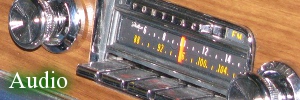















Commercial Trucks Adopt Fuel-Saving Technology |
|---|


|
Art Chimes
Washington, D.C.
May 24, 2005
Audio Version 2,318KB mp3
Audio Version 767KB RealPlayer
The higher the cost of fuel, the more vehicle operators pay attention to fuel efficiency. It's true for Americans filling up the family car. And it's true for operators of big trucks and buses. So manufacturers are using new technologies to get more work out of every liter of fuel that goes into those heavy-duty vehicles.
Except for its promotional paint job, the bus that pulls up to the curb looks pretty much like any other modern city bus here in Washington. But this is no ordinary transit vehicle.
"It has a diesel hybrid propulsion system," says Dave Mikoryak, "and the reason we did it is, was obviously for a lot of environmental reasons to meet upcoming and current emission standards. And also to improve fuel efficiency in vehicles."
For about a century, the internal combustion engine -- gasoline or diesel -- has been the global standard for motor vehicles. In the past few years, hybrid vehicles have been making small inroads. They use a smaller engine combined with electric motors to supply power to the wheels. The technology reduces emissions and increases fuel economy and is slowly propagating out from the small economy cars in which it first appeared.
At a meeting of the Society of Automotive Engineers in Washington last week, companies developing hybrid technology for trucks and other heavy-duty vehicles were showing off their stuff.
Dave Mikoryak, of General Motors' Allison Transmission unit, explained some of the ways his company's bus gets better fuel economy and improved acceleration. "We are able to achieve that by downsizing the engine significantly from a large bus engine down to a medium-duty truck or even a large pickup truck-size engine, and also use regenerative braking to recapture energy to help with the vehicle launch."
Regenerative braking recaptures some of the energy as the vehicles stop. City buses often stop every couple of blocks. When a normal vehicle brakes to a stop, the energy of its forward motion is dissipated as heat from the friction of the brakes. With regenerative braking, that energy is captured as electricity in batteries, which can then be used to help get the vehicle going again. That's a big plus for a city bus that is constantly in stop-and-go service.
Mr. Mikoryak says some 350 GM hybrid buses are now in use in the United States. Energy savings can be teased out of other parts of the vehicle, too. Jon Morrow of the Oshkosh Truck Corporation explained some of the efficiencies built into a prototype vehicle his company had on display. "In addition to the hybrid-electric drive system, it also has a high-efficiency cooling package. It cuts the energy consumption for engine and system cooling by 50%. The hybrid package is intended to provide a 30-40% fuel savings in a day."
Another high tech vehicle on display was a big, long-haul truck from Volvo. American truckers often sleep in their vehicles as they carry cargo from one end of the country to another. Luxurious sleeper cabins have air conditioning, television and other conveniences. To power them, the truck engine often idles away as the driver sleeps, using an estimated 8,000 liters of fuel a year. One simple solution is a system that allows drivers to plug in to an electric power outlet at a truck stop.
"We'll have a 625 horsepower engine in a truck like this," says Volvo's Skip Yeakel. "You don't need that much to run an air conditioning system so we've put on what I call AC HVAC -- alternating current-powered heating, ventilating and air conditioning. Plug in, shut down [the engine]. About 2 kilowatts an hour is the average."
Heavy vehicles such as buses and trucks are only a small percentage of the U.S.
vehicle fleet, but because of their size and the fact that they're on the road many more hours a day than the typical passenger car, they have a disproportionate impact on both the environment and energy consumption. stressed the importance of improving fuel economy in this segment of the vehicle fleet.
"Because so much of our commerce is dependent on trucks, which haul more than 65% of all the freight tonnage transported in the United States, it is essential that we make this sector as efficient as we possibly can," said Mr. Bodman. "If the technologies currently being researched can reach commercial maturity and market acceptance, we can increase the fuel economy of the best new long-haul trucks by more than 50% in the next 15 years."
Currently there are government regulations limiting emissions from heavy trucks, but there are no rules on fuel economy. However, because fuel consumption is an important part of the operating cost of these vehicles, manufacturers can take competitive advantage of features that save diesel fuel.
